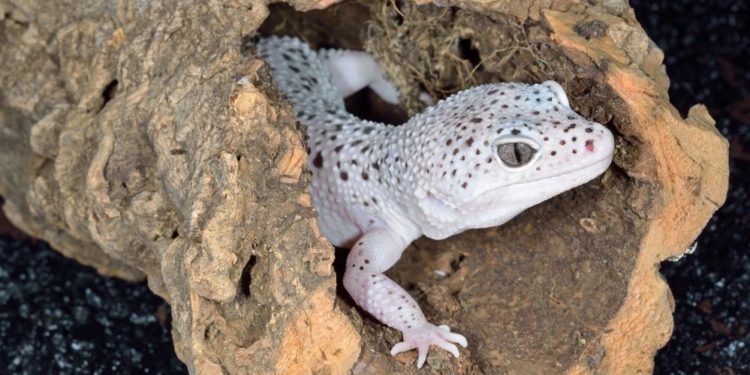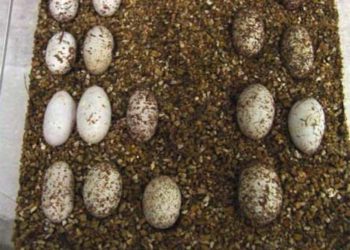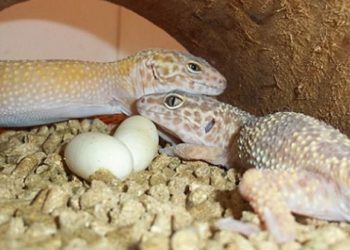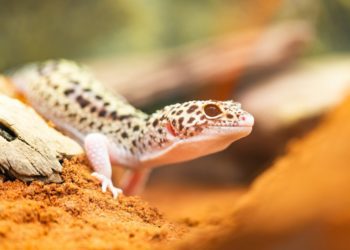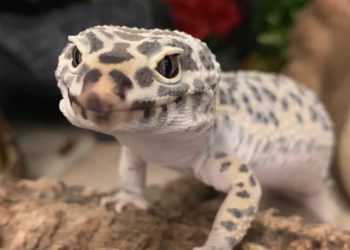Leopard geckos are reptiles that consist of a few different habits. You can find them sleeping away from the whole winter, which is popularly known as brumation. This is a pretty common habit of all the healthy leopard geckos, and there is no harm in going through this period.
The brumation period is a resting period for the geckos and they do not eat or defecate at this time. This happens during the months of winter. The metabolism slows down at this time and they do not move at this period.
Brumation is the period in which bears, bats and even a few insects go under. In the case of leopard geckos, they sleep for 80 per cent of the daytime when their brumation starts. They stay to the basking spot and do not move much. Hibernation of brumation cycle is much necessary for the leopard gecko and some other reptiles.
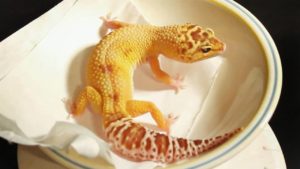
Contents
Why the leopard gecko brumate?
Leopard geckos do not go to complete dormant state while brumating. This is why it is not called hibernation but brumation. This is the period of semi dormancy and it is quite helpful for the reptiles with cold blood during the month of winter.
This is the slowing down of the metabolism process of the leopard gecko. ectothermic creatures like them need to spend cold season this way so they do not get to spend much energy during this period. This is different than hibernation as the process do not involve drastic stopping of movement.
As leopard geckos are creatures of the temperate region they are not genetically used to with very cold winters. Ectothermic creatures can modify their body temperature with the outer atmosphere. When the temperature drops down, they go inside some burrows and the normal activity level lowers down. They come out of this state once the season changes and the outside temperature level rises.
The necessity of this process
Energy conservation is the prior need of the brumation. Other benefits of the brumation process are not quite figured out by so far. In wild the leopard geckos are they brumate according to their lifestyle. Those that not live in the colder regions do not brumate at all.
Breeders have found a few interesting facts about brumation. The leopard geckos that brumate often produce a larger and better quality of offsprings. So it can be apprehended that brumation has something to do with healthy hormone secretion and that improves their reproductive cycle.
There are quite a few risks regarding the brumation process of captivated leopard geckos. There are many complicated tasks involved in preparing for the brumation process. If you are not interested in the breed the leopard gecko, then you may not need to continue the process.
Risks of brumation
The prior and primary issue with brumation is, the left food on the stomach of the leopard gecko can rot and can be fatal to the reptile. You must allow the gecko to release all its bowels before it goes for brumation.
Also, the chance of dying due to the lower temperature is much, during this period. You need to keep the gecko in room temperature but once the temperature of the outside atmosphere drops, you will not be able to gauge that and that can prove to be severe for the gecko.
When you have a sickly and underweight gecko, do not go for brumation. This is the period within which the gecko will not eat anything. They completely survive on their stored body fat, and if your pet gecko is not healthy enough or has ample stored fat, then it will not be able to survive this brumation period and come back to normalcy.
How you can help geckos for brumation?
Arranging for the brumation is a step by step process. This is a necessary process for your gecko if you plan to breed, as per some breeders. But there are others who do not opt for brumation and yet they have achieved a clutch of good and healthy gecko babies. So if you decide to brumate your geckos, this is how you can help them.
You need to turn the heater off when the brumation starts. Before that, you need to keep the temperature at a lower level. This lowering temperature should be continued for a week and then you can turn the heater off from where it has been installed.
As geckos are adjusted to humid and warm weather, you must make sure that the temperature of the enclosure, or wherever you are keeping it for brumation, is not less than 70 degrees Fahrenheit, as that can be proven to be dangerous for the leopard gecko.
Expect the gecko to be far less active than normal times. That is okay, as the leopard gecko will be resting at this time and staying just alive. They do sleep a lot at this time and that is how they spend the cold season. The large fat stores in their tails are being used at this time to provide them with minimal energy to keep living. That is how they manage to live without food at this time.
When you see the symptoms of hibernation, you must be sure that the body weight of the leopard gecko is ideal. Being in good health is mandatory when the gecko is ready to hibernate, as the stored body fat will be providing them nutrition through the months. You may need to take your gecko to the herp vet if you see symptoms of hibernation and is not sure of its health condition.
If the leopard gecko is not in good health condition then it is fatal for it to go in hibernation. This reptile may not be able to withstand the starvation of the hibernating period and can die as the consequence.
When does gecko brumate?
This habit of brumation is normally seen in geckos when the outside temperature drops down. Leopard geckos prefer to stay warm and thus when the winter arrives, they go to brumate in some burrow in their wild region. When captivated then seek the furthest corner of the enclosure, if you do not provide them with some calm corner of the house to brumate.
How much temperature is required for brumation?
At the initial stage of brumation, the daytime temperature should be 90 degrees Fahrenheit while the basking spot should be 95 degrees hot.
At the nighttime, the temperature should be around 70 degrees Fahrenheit.
You can keep the lights on for 12 hours and rest 12 hours the light should be switched off.
When brumation actually starts, the parameters change slightly.
The daytime temperature should be around 78 degrees Fahrenheit and at night it will be stuck to 70 degrees as usual.
The light cycle should be followed in the same 12 hours system.
There should be a slight and gradual change in the day by day routine of brumation. You cannot just move from initiative phase to regular brumation phase. The sudden change in temperature and lighting will shock and distress the gecko, and it can go under stress due to that reason.
Also, you need to check the hydration level as well as the weight of your gecko during and before the brumation. This weighing should be done at a regular interval. The gecko must not lose more than 10 per cent of its weight that it had at pre-brumation period, as that can be proven unhealthy for it.
As we have already mentioned, the temperature of the hibernating place or cold storage, as it is commonly called, should be around 50 degree. It should not get above 68 degree or go below 50 degree. If the temperature falls below 50 degree, you need to move the gecko to a warmer place.
If the weight loss is fast and it loses more than 10% of its weight, you need to be cautious and stop the process. This weight loss can be due to the hydration problem or some parasites that are being loaded on its body.
Check the tail of the gecko, as when it starts losing weight, this portion becomes thinner soon. This also can be caused by the dehydration so you must take care of the gecko and should not continue with the brumation after this gecko gets sick.
How to synchronize the brumation with the breeding cycle?
As brumation is done mostly to get the gecko breed successfully, there can be some connection of breeding with brumation. It has been seen that after brumation, most of the leopard geckos come out with pregnancy.
What are the symptoms of non-voluntary brumation?
Brumation is the period when the leopard gecko feels lethargic and sluggish. When you own a leopard gecko, you may or may not choose to let the gecko brumate. So when you do not make any preparation for the brumation the gecko will show a few symptoms of self-motivated brumation when it is winter.
It can stay at the hot side of the enclosure for the whole day, not moving much and roam around in the other parts of the terrarium.
- Lethargy is one foremost and prior symbol that your gecko is bromating. They stop being active and do not bother to play with the accessories that are put inside the enclosure.
- Even if the gecko makes a few moves, those are much slower and you will understand that they are barely enjoying the moves.
- Eating very less or not eating at all is another prominent symptom that they are brumating. They do not feel hungry at all and can only eat once in two days.
- For the largest part of the day, they will stay calm and sleep. They will even sleep during the daytime as well as the night time, which means they are undergoing the stages of brumation.
- They do not even poop for days. This makes sense as they tend to eat so little and that too once in a few days. However, if they have the excretion in their system during this brumation period, that can rot and make the gecko sick. So it is better not to feed them at this period, so there will be less chance of falling sick due to the defecation.
- The gecko can be seen hidden in some hideouts in its enclosure. You may not be able to find it in the favourite spot of the enclosure for days. It will stay there for weeks. This is a typical sign that the gecko is bromating.
Is the gecko bromating or is stressed?
The signs and symptoms that we have discussed above are quite similar to the signs of stress as well. Leopard geckos are quite easy to be stressed and that can be the cause of all the aforementioned signs. They will eat less, stop pooping and stay inactively on the floor of the terrarium. The state is so similar to bromating that the new owners may get confused over this matter.
However, the stressful period does not last for more than 3 to 4 days, but if the gecko is bromating, it will be a month-long matter. So if you have adopted a leopard gecko for the first time, check if the season is winter or the outside temperature has suddenly dropped. This is an acute cause of brumation if the cold pervades for more than weeks.
If this is a normal sunny season and yet the gecko is behaving weirdly, then let it be at peace for 3 to 4 days. But if the stressful gecko does not retain to normal life, then you need to check the pet with a veterinarian to know that if something is not okay with the health of the gecko.
Where does leopard gecko brumate in wild?
In wild regions, where there are scanty places to stay in a time of brumation, geckos seen to have bromated in groups. They can stay on the trees or go inside a hole under the ground in a time of brumation. The place where they brumate must be well insulated and it should enable the passing of air.
When the outside temperature regains warmth, they come out of their brumation place and start their regular normal activity.

Is it safe to put off heat during winter?
The owners are often worried about this matter. Leopard geckos need to be kept at the normal room temperature while they are bromating and thus you need to shut off the power source at this period. The reason behind this ritual is, power source keeps their metabolism at normal speed and that is not ideal at the time of brumation.
When the leopard gecko is eating a regular amount of food and doing its usual activities, then it needs its regular dosage of heat. But at the time of brumation, they stop eating. The stored fat in their body, more specifically tail portion, is burned out to provide them with a limited source of energy to barely live.
If the power source is on, then the gecko will not be able to stay calm and also the fat will be burned in a rapid way. This will lead to sickness and frailty in the leopard gecko. So if you are decided upon having your leopard gecko bromated, then keep the heat source off. Do not be worried as this is a completely safe thing to do.
How long does the gecko brumate?
It takes 6 to 8 weeks to finish the brumation and then you can start reversing the process. You need to keep it in the enclosure and the temperature should be like the same it was on the initiating stage. This time also the light cycle should be regulated.
When you will keep it in the normal cycle and atmosphere it will be adjusted with the usual cycle. It will be active and eat and drink like normal times.
It will start searching for its food one or two days after the brumation is over. Start feeding it with some more than the regular quantity as, during the brumation period, the fat store of the body has been depleted.
Do not overfeed for more than 3 days as that can make it obese. Just fulfilling its appetite with littlebit more food than usual times will be good. The excess amount of food will make it healthy as it will be consumed with the help of basking heat in the coming weeks.
Why the gecko does not eat?
The leopard gecko simply lies down and does not move much during the brumation period. The reason is, this period they do not feel hunger due to the slow metabolism in their body. They refuse to move much and roam around as they stay calm and try to process the stored fat in their body. Thus they do not need any food at the brumation period.
How many times a do gecko brumate in a year?
This is a yearly ritual for the geckos. They do not repeat the process more than once in a year, and even some of them do not go for brumation at all. As we have mentioned that geckos are naturally the inhabitants of warm and humid regions, they need to go for brumation if staying in a cold region.
But if the general temperature of the region does not drop down much then it is completely okay for the leopard gecko to not brumate at all. So if your gecko is not preparing to brumate even if it is winter outside, this is actually normal. Do not panic about why it is behaving normally and staying active all the time. The temperature is not uncomfortable for it and that is why it will not brumate.
The period of hibernation can last for 1 to 3 months depending upon the nature, age and health condition of the leopard gecko. However, you should not be worried and maintain healthy environment in the room so the gecko stays well during this period.
Do leopard geckos hibernate in winter?
When the winter season starts, you can see a definite change in the behavior of the leopard gecko. The early symptoms will be like less eating and more sleeping. This pattern will be followed for a few days when the feeding will become lesser in number and amount.
Hibernation is the process of staying dormant through the months of winter. There is a particular term “brumation” for the leopard gecko and some other reptiles, which means staying in hibernated situation for months.
The reptiles that are originally from the temperate regions possess a particular metabolic state which allows them to sleep in the winter months without any distraction or pause. This is a regular process and this is quite common in leopard gecko. so when you see the gecko getting inactive in the months of winter, prepare for the situation.
How to prepare the enclosure for the hibernation of leopard gecko?
After the last feeding, you need to make arrangements for the proper heat and light in the enclosure. This time is to clear the bowels of the leopard gecko. During hibernation the process of digestion totally stops. So you must give it ample time to clear the bowels. Or else it will rot in their intestine and that can be severe for the leopard gecko.
You must maintain the hydration level of the enclosure as well as the gecko. you can let it bath daily and keep the bowl of water along with some wet paper towels inside the cage to make the atmosphere humid. The gecko will absorb the necessary humidity and will be healthy.
After you give the gecko ample time to get free from the bowel, shut the heat and light sources off. This condition will be one week long, when you will give the gecko enough time to get adjusted with the normal room temperature.
After a week is passed in normal room temperature, you have to shift the leopard gecko to a cooler space of your house. The room where you shift it must not be frequently visited by you or other members. Here the temperature should remain around or below 68 degree Fahrenheit.
Conclusion
Owners of the leopard geckos are mostly well aware of this process called brumation. This is a natural habit among pet leopard geckos as well as the wild ones. Still, there are debates about how brumation is effective for breeding or how it affects the health of the leopard gecko.
Unlike some of the reptiles, brumation is not a mandatory part of every leopard geckos’ life. So you may opt for it or may not if you have owned a leopard gecko. This is somehow stressful a process for some leopard geckos and also we have mentioned a few risks regarding it. Breeding is possible without brumation and some of the breeders even have proved that fact to be true.
More:


